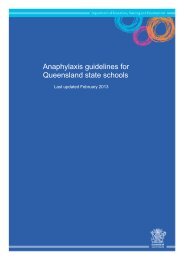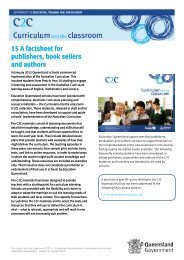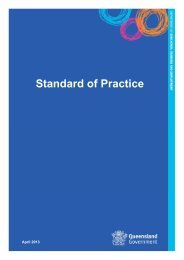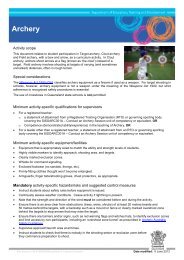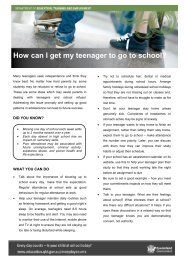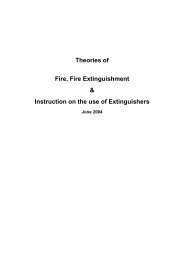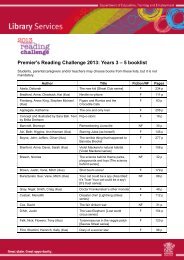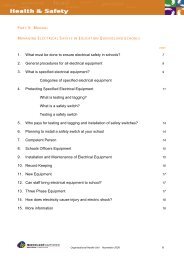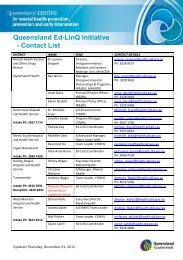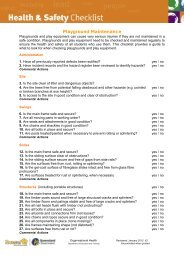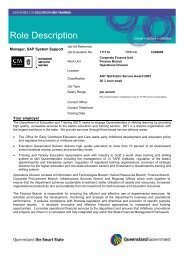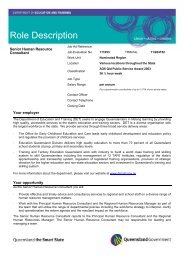Smart Choices - Healthy Food and Drink Supply Strategy for ...
Smart Choices - Healthy Food and Drink Supply Strategy for ...
Smart Choices - Healthy Food and Drink Supply Strategy for ...
You also want an ePaper? Increase the reach of your titles
YUMPU automatically turns print PDFs into web optimized ePapers that Google loves.
Examples of a serve<br />
Bread, cereals, rice, pasta, noodles<br />
2 slices of bread<br />
1 medium bread roll<br />
1 cup cooked rice, pasta, or noodles<br />
Vegetables <strong>and</strong> legumes (choose a variety)<br />
Starchy vegetables<br />
1 medium potato or yam<br />
½ medium sweet potato<br />
1 medium parsnip<br />
Dark green leafy vegetables<br />
½ cup cabbage, spinach, silverbeet, broccoli, cauliflower or brussel sprouts<br />
1 cup cooked porridge<br />
1 cup breakfast cereal flakes or 1/2 cup muesli<br />
Legumes <strong>and</strong> other vegetables<br />
1 cup lettuce or salad vegetables<br />
½ cup broad beans, lentils, peas, green beans, zucchini, mushrooms, tomatoes, capsicum, cucumber, sweetcorn,<br />
turnips, swede, sprouts, celery, eggplant etc.<br />
Fruit<br />
1 piece medium sized fruit (<strong>for</strong> example apple,<br />
orange, mango, m<strong>and</strong>arin, banana, pear, peach etc.)<br />
2 pieces of smaller fruit <strong>for</strong> example apricots, kiwi<br />
fruit, plums, figs<br />
1 cup diced pieces or canned fruit<br />
Milks, yoghurt, cheese <strong>and</strong> alternatives<br />
250 ml glass or one cup of milk (can be fresh, long<br />
life or reconstituted milk)<br />
½ cup evaporated milk<br />
40 g (2 slices) of cheese<br />
250 ml (1 cup custard)<br />
½ cup fruit juice<br />
¼ medium melon (rockmelon, honeydew)<br />
Dried fruit <strong>for</strong> example 4 dried apricots, 1½ tablespoons<br />
sultanas<br />
About 20 grapes or cherries<br />
About 8 strawberries<br />
200 g (1 small carton) of yoghurt, plain or fruit, or, as an<br />
alternative try:<br />
1 cup of calcium-<strong>for</strong>tified soy milk<br />
½ cup pink salmon with bones<br />
Meat, fish, poultry <strong>and</strong> alternatives<br />
65–100 g cooked meat or chicken (<strong>for</strong> example ½ cup mince, 2 small chops or 2 slices roast meat)<br />
80–120 g cooked fish fillet, or as an alternative try:<br />
2 small eggs<br />
½ cup cooked (dried) beans, lentils, chick-peas, split peas or canned beans<br />
1/3 cup peanuts or almonds<br />
Extras<br />
These foods can occasionally be included <strong>for</strong> variety. They are generally higher in saturated fat <strong>and</strong>/or sugar, kilojoules<br />
<strong>and</strong> salt.<br />
Some examples include:<br />
30 g potato crisps<br />
1 small–medium piece of plain cake or 1 bun<br />
1 slice pizza = 2 extras<br />
3–4 plain sweet biscuits<br />
1 can soft drink or 2 glasses cordial<br />
Half a small chocolate bar<br />
2 scoops ice-cream<br />
60 g jam, honey (1 tablespoon)<br />
1 meat pie or pasty = 3 extras<br />
2 tablespoons of cream or mayonnaise<br />
Source: The Australian Guide to <strong>Healthy</strong> Eating, Commonwealth Department of Health <strong>and</strong> Family Services, 1998.<br />
The smart choices food<br />
<strong>and</strong> drink selector<br />
The <strong>Smart</strong> <strong>Choices</strong> – <strong>Food</strong> <strong>and</strong> <strong>Drink</strong> Selector<br />
on pages 7–18 assists with making selections<br />
on foods <strong>and</strong> drinks to be supplied in<br />
schools. <strong>Food</strong>s <strong>and</strong> drinks have been<br />
classified into three categories<br />
according to their nutritional value:<br />
Green, Amber <strong>and</strong> Red.<br />
GREEN ‘Have plenty’<br />
Encourage <strong>and</strong> promote these foods<br />
<strong>and</strong> drinks in the school.<br />
AMBER ‘Select carefully’<br />
Do not let these foods <strong>and</strong> drinks dominate<br />
choices <strong>and</strong> avoid large serve sizes.<br />
RED ‘Occasional’<br />
Limit the availability of these foods <strong>and</strong> drinks<br />
to no more than two occasions per term.<br />
You will note that there is a clear distinction<br />
between the AMBER <strong>and</strong> RED categories. This<br />
is because foods in the RED category are to<br />
be available on no more than two occasions<br />
per term. A set of nutrient criteria is provided<br />
(on page 15) that will enable you to determine<br />
whether a certain food sits within the RED<br />
category.<br />
Staff <strong>and</strong> parents also eat from the school<br />
tuckshop. While their needs may be different<br />
to children, it is important that adults in the<br />
school model healthy food choices.<br />
Links to the school curriculum<br />
The school curriculum seeks to improve<br />
students’ underst<strong>and</strong>ing of good nutrition<br />
<strong>and</strong> develop the skills to make positive health<br />
decisions. Learning about healthier food<br />
choices may encourage children to try new<br />
foods. Classroom activities also provide an<br />
opportunity <strong>for</strong> students to be involved in<br />
planning <strong>and</strong> promoting healthier foods.<br />
The <strong>Smart</strong> <strong>Choices</strong> – <strong>Food</strong> <strong>and</strong> <strong>Drink</strong> Spectrum<br />
which appears on the following page is<br />
a visual guide that shows where certain<br />
foods <strong>and</strong> drinks fit. The spectrum has been<br />
reproduced as a poster <strong>and</strong> accompanies this<br />
resource package.<br />
6 7



